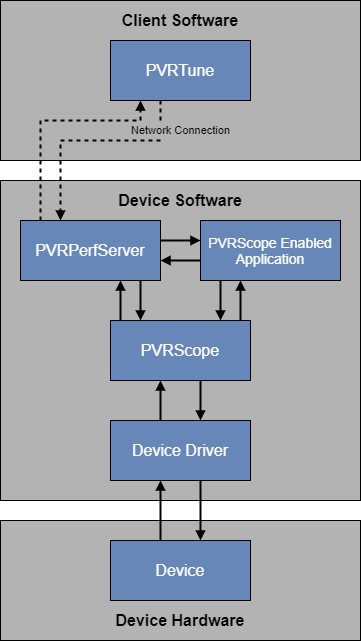Introduction to the PVRTune Manual¶
Document Overview¶
This document is a complete user manual for PVRTune and PVRPerfServer. It includes installation instructions, functionality explanations, and useful tips on how to get the most out of the application.
What is PVRTune?¶
PVRTune is a performance analysis tool for PowerVR graphics cores. It uses driver-level counters and hardware registers to provide real-time data on the performance of an application running on a PowerVR GPU.
PVRTune has three primary elements:
PVRPerfServer - This is a command-line application that reads counters and registers from the drivers. PVRPerfServer then either saves the data to a .PVRTune file or transmits the data to PVRTune GUI over a network. PVRPerfServer can also read from any application which uses the PVRScope library. Note: This application only runs on PowerVR devices.
PVRTune GUI - This is a client-side desktop profiling application used to analyse the performance of PowerVR graphics cores. It provides a real-time graphical representation of the information sent by a device through PVRPerfServer.
PVRScope - This is a client-side desktop profiling application used to analyse the performance of PowerVR graphics cores. It provides a real-time graphical representation of the information sent by a device through PVRPerfServer.
The following sections will explain how to set up each of these elements to analyse application performance on PowerVR devices. There will be a particular focus on setting up PVRPerfServer and the PVRTune GUI. The image below demonstrates how these different elements interact with each other and the device driver.

Statement of Support¶
This software is compatible with up to the following:
Host platform (PVRTune GUI): Windows (x86_64), Linux (x86_64), and macOS (x86_64;arm64).
Client platform (PVRPerfServer, PVRScope): Android, Linux, macOS, QNX, Tizen, Windows operating systems (OS); on many architectures.
Rogue DDK supported from branch 1.9 to 23.2 inclusive.
NNA Support.
PVRPerfServer supported only at a matching revision to PVRTune.
PVRScope library and .PVRTune file support from SDK release 17.2 onwards.
Revisions and versions not stated here may work, but are not guaranteed to be compatible.

